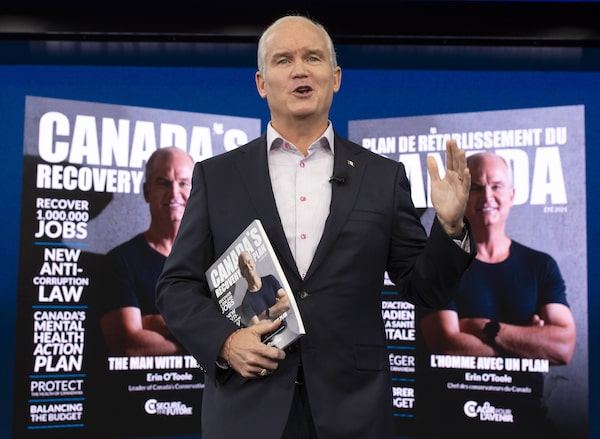
Conservative Leader Erin O'Toole reveals his party's recovery plan as he campaigns Aug. 16, 2021 in Ottawa.Ryan Remiorz/The Canadian Press
The Conservative Party of Canada is framing its bid to unseat the Liberals in terms of job creation, promising to kickstart a hiring spree with tax incentives to encourage business investment over the next several years.
In his first appearance of the campaign, Conservative Leader Erin O’Toole committed to creating a million jobs over the next year, echoing a similar pledge the Liberals made last fall when the level of unemployment was considerably higher than today.
Both parties say they would extend government support to sectors of the economy hardest hit by the pandemic. The Conservative election platform, published on Monday, puts additional emphasis on spurring job creation by promoting business investment.
A pair of tax credits are at the heart of the plan. The party is proposing a 5-per-cent tax credit for capital investments made by companies in 2022 and 2023, with small businesses eligible for a refund on the first $25,000 they invest. A second proposal is to provide a 25-per-cent tax credit to individuals that invest in small businesses over the next two years, on amounts of up to $100,000.
Other items in the Conservative platform include reducing taxes on income earned through intellectual property developed in Canada, and allowing technology companies to issue special tax-deductible shares designed for early-stage financing similar to mining companies.
The goal of these proposals goes beyond promoting short-term job creation and recovering positions lost since the beginning of the COVID-19 pandemic, Mr. O’Toole said in a Monday news conference. According to a Bank of Canada analysis published last month, the economy needs to add about 550,000 jobs to reach the prepandemic employment rate.
The Conservatives propose to balance the federal budget by 2031. To hit this goal, the Canadian economy needs to continuously grow at 3 per cent or more a year, according to the party platform. That is a significantly higher rate of GDP growth than Canada achieved in the decade before the pandemic.
“We’ve chosen an appropriate target based on a very ambitious set of economic development policies,” Mr. O’Toole said when asked whether 3-per-cent growth was a reasonable assumption. “Our first pillar, one million jobs in one year, will help recover the jobs lost in the pandemic and also get sectors of our economy surging.”
The Conservative plan has not yet been costed by the Parliamentary Budget Office.
On the crucial issue of housing, the Conservatives say they would encourage the construction of an additional one million homes over the next three years by freeing up federally owned land and tying municipal transportation funding to urban densification, among other ideas. The party said it wants to encourage a new market for seven- and 10-year mortgages, and to put a two-year ban on investment in Canadian homes by people not living in or moving to Canada.
The Conservatives are looking to reverse or restrict several key Liberal economic initiatives. The party says it would abolish the Canada Infrastructure Bank, the $35-billion institution the Liberals launched in 2017 to facilitate public-private investment in major infrastructure projects, and redistribute the money to other infrastructure projects.
The Conservatives also want to dial back Canada’s carbon tax, proposing to limit it to $50 a tonne, compared with the Liberal plan to raise the price to $170 a tonne by 2030.
In other respects, the Conservative economic plan looks similar to Liberal thinking, particularly when it comes to industrial policy – the practice of funnelling government money toward industries deemed to be of national importance.
The Conservatives said they would spend $5-billion over the next five years funding projects related to the hydrogen industry, small nuclear reactors, electric vehicle and battery production and pharmaceuticals – all areas the Liberals have identified for targeted government spending.
The Conservative platform takes several other steps in the direction of economic nationalism, promising to “repatriate and diversify supply chains to move them away from China” and to “reform Canada’s procurement rules to create a vital national-interest category that must be sourced in Canada.”
Your time is valuable. Have the Top Business Headlines newsletter conveniently delivered to your inbox in the morning or evening. Sign up today.